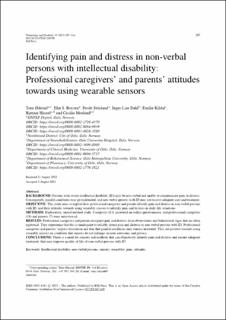| dc.contributor.author | Øderud, Tone | |
| dc.contributor.author | Boysen, Elin Sundby | |
| dc.contributor.author | Strisland, Frode | |
| dc.contributor.author | Dahl, Inger-Lise | |
| dc.contributor.author | Bull, Emilie Meyer | |
| dc.contributor.author | Hassel, Bjørnar | |
| dc.contributor.author | Morland, Cecilie | |
| dc.date.accessioned | 2024-02-06T07:27:33Z | |
| dc.date.available | 2024-02-06T07:27:33Z | |
| dc.date.created | 2023-10-20T09:28:45Z | |
| dc.date.issued | 2023 | |
| dc.identifier.citation | Technology and Disability. 2023, 35 (3), 207-216. | en_US |
| dc.identifier.issn | 1055-4181 | |
| dc.identifier.uri | https://hdl.handle.net/11250/3115801 | |
| dc.description.abstract | BACKGROUND: Persons with severe intellectual disability (ID) may be non-verbal and unable to communicate pain or distress.
Consequently, painful conditions may go undetected, and non-verbal persons with ID may not receive adequate care and treatment.
OBJECTIVE: This study aims to explore how professional caregivers and parents identify pain and distress in non-verbal persons
with ID, and their attitudes towards using wearable sensors to identify pain and distress in daily life situations.
METHODS: Exploratory, mixed method study. Caregivers (83) answered an online questionnaire, and professional caregivers
(18) and parents (7) were interviewed.
RESULTS: Professional caregivers and parents recognise pain and distress from observations and behavioural signs that are often
equivocal. They experience that this is inadequate to reliably detect pain and distress in non-verbal persons with ID. Professional
caregivers and parents’ express frustration and fear that painful conditions may remain untreated. They are positive towards using
wearable sensors on condition that sensors do not infringe on user autonomy and privacy.
CONCLUSIONS: There is a need for sensors and methods that can objectively identify pain and distress and ensure adequate
treatment, that may improve quality of life of non-verbal persons with ID. | en_US |
| dc.language.iso | eng | en_US |
| dc.rights | Navngivelse-Ikkekommersiell 4.0 Internasjonal | * |
| dc.rights.uri | http://creativecommons.org/licenses/by-nc/4.0/deed.no | * |
| dc.title | Identifying pain and distress in non-verbal persons with intellectual disability: Professional caregivers' and parents' attitudes towards using wearable sensors | en_US |
| dc.type | Peer reviewed | en_US |
| dc.type | Journal article | en_US |
| dc.description.version | publishedVersion | en_US |
| cristin.ispublished | true | |
| cristin.fulltext | original | |
| cristin.qualitycode | 1 | |
| dc.identifier.doi | 10.3233/TAD-220390 | |
| dc.identifier.cristin | 2186609 | |
| dc.source.journal | Technology and Disability | en_US |
| dc.source.volume | 35 | en_US |
| dc.source.issue | 3 | en_US |
| dc.source.pagenumber | 207-216 | en_US |

